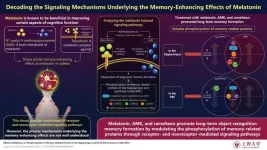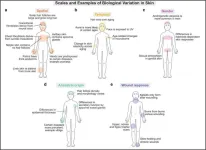(Press-News.org) Nearly one million people in the United States are living with Parkinson’s disease, making it the second-most common neurodegenerative disease after Alzheimer’s. Current medical treatments for Parkinson’s are focused on helping people manage symptoms. But the underlying mechanisms of the neurological disorder remain poorly understood.
Tamily Weissman, associate professor of biology and department chair, is working to change that. Parkinson’s symptoms occur because of a drop in dopamine levels when certain brain cells die. Scientists know that abnormal clumping of certain proteins inside key neurons is involved; however, the exact mechanisms are unclear.
“Something is causing these proteins to bind together and form aggregates,” says Weissman. “And we don’t yet understand what that mechanism does to cells or why the cells are dying.”
Similar protein aggregation is associated with other neurological disorders, including Alzheimer’s, amyotrophic lateral sclerosis (ALS), and Huntington’s disease. A better understanding of these protein clumps, known as Lewy Bodies, could lead to breakthrough discoveries and open up new paths to treatment.
Using Zebrafish Models
Weissman’s work is focused on alpha-synuclein, the abnormally clumping protein found in the brains of Parkinson’s patients. The National Institutes of Health (NIH) is funding her innovative approach, which examines how this protein behaves in zebrafish models. She and her team are looking at the factors surrounding the phosphorylation at a protein site known as serine 129. The site “gets tagged” with a phosphate group, explains Weissman, who is also known for her work on a multicolor cell-labeling technique called Brainbow.
“If you look at all of the aggregated alpha-synuclein, you’ll wonder, ‘Why has it all been tagged at that site? And in the same way? Nobody knows. It’s a total mystery,” she says.
Weissman and her colleagues recently provided one key clue by confirming that phosphorylation at serine 129 cannot be the sole driver of the protein clumping.
“Our question is, ‘What else, in addition to the tag, needs to be in place for the clumping to occur?’” says Weissman.
Faculty-Student Summer Research
Weissman conducts her research with undergraduate students who work in the Weissman Lab. Together, they conduct experiments that include injecting zebrafish embryos with alpha-synuclein DNA and manipulating the protein at different sites. They mark it with fluorescence and, because the embryo is transparent, can then observe its behavior using a confocal microscope. This specialized microscope allows them to image the process in a high-resolution way, as well as to make observations over time.
This summer, four students worked in the Weissman Lab as part of the 10-week John S. Rogers Science Research program, which helps prepare undergraduates for science careers through faculty-student research. The students―including Biology majors Brandon Apresa ’24 and Claire Zawadzki ’25, along with Biochemistry and Biology major Brendan Creeks ’24 and Psychology major Lily Schainker ’25―have spent the summer gaining hands-on lab experience through specialized training, as well as by conducting experiments and collecting data. Most of them will continue working in the lab into the fall semester as part of independent study courses. They also work closely with Weissman’s full-time lab technician, Nicole Brockway.
Brandon Apresa BA ’24 will pursue the work this year as part of his senior thesis.
“I’ve been declared as a biology major for a while,” said Apresa, who is also minoring neuroscience. “But I’ve never felt like a scientist until now. I feel like I’m doing work that really matters. And it’s really freaking cool to be able to do all these things that we’re doing and have this opportunity to work with awesome people.”
In addition, the team is building collaborations with colleagues at Reed College and at Oregon Health & Science University, where researchers are also exploring the mechanisms behind alpha-synuclein. Dr. Vivek Unni’s lab is a direct collaborator on this research.
Weissman is excited about the work ahead and grateful for the support of the NIH and for the Office of Sponsored Projects and Research Compliance (SPARC) at Lewis & Clark.
Says Weissman, “The SPARC office is one of the reasons why Lewis & Clark has done such a good job with securing and managing important research grants like this one.”
END
Understanding the neurological mechanisms behind Parkinson’s disease
Associate Professor of Biology Tamily Weissman’s research, supported by the National Institutes of Health (NIH), could shed light on new treatment pathways for Parkinson’s and other neurological disorders
2023-08-21
ELSE PRESS RELEASES FROM THIS DATE:
Space travel depletes red blood cells and bone, but bone marrow fat may come to the rescue
2023-08-21
A study of 14 astronauts suggests that while space travel depletes red blood cells and bone, the body can eventually replenish them back on Earth with the help of fat stored in the bone marrow. The study, published in Nature Communications, has important implications for health in space and on Earth.
“We found that astronauts had significantly less fat in their bone marrow about a month after returning to Earth,” said senior study author Dr. Guy Trudel, a rehabilitation physician and researcher at The Ottawa Hospital and professor at the University of Ottawa. ...
COVID-19 may trigger new-onset high blood pressure
2023-08-21
Research Highlights:
An analysis of more than 45,000 people infected with SARS-CoV-2 found a significant association between the virus and the development of persistent high blood pressure among those with no prior history of high blood pressure.
In addition, people with COVID-19 infection and no history of high blood pressure were significantly more likely to develop persistent high blood pressure compared to people with the influenza virus.
People with COVID-19 who are over age 40, men, Black adults or those with preexisting ...
Overuse of social media and devices top parent concerns as kids head back to school
2023-08-21
ANN ARBOR, Mich. – As children head back to school, two issues have climbed higher on their parents’ list of concerns: the role of social media and the internet in kids’ lives.
Over half of parents also rate mental health issues as leading health concerns for children and teens, according to the University of Michigan Health C.S. Mott Children’s Hospital National Poll on Children’s Health.
Overall, emotional health and technology use dominated this year’s top 10 list of parent concerns about health-related issues for kids in the U.S.– surpassing childhood obesity, which parents rated the number one children’s health issue ...
Citizen scientists reveal how the common wasp spreads across UK
2023-08-21
The Big Wasp Survey, a citizen science project involving thousands of volunteers throughout the UK, has yielded important genetic insights into the common wasp, reports a study led by UCL researchers.
Using data and samples of Vespula vulgaris (a species of yellowjacket wasp known as the Common Wasp) collected by amateur ‘citizen scientists’, the researchers conducted the first large-scale genetic analysis of the insect across its native range.
The insights, published in Insect Molecular Biology, revealed a single population of the wasp across Britain, while the insect’s genetics were more differentiated across the Irish Sea in Northern Ireland. The researchers ...
Melatonin and its derivatives enhance long-term object recognition memory
2023-08-21
Multiple studies have demonstrated the memory-enhancing effects of melatonin and its derivatives in animal models. It is also known that the formation of both short- and long-term memories require the phosphorylation of certain memory-related proteins. However, the molecular mechanisms underlying melatonin-induced memory enhancement have remained elusive. Now, medical researchers from Sophia University, Japan, have made important findings that contribute significantly to the elucidation of the underlying mechanisms in a recent article that was made available online on 10 May 2023 and published in Volume 34 Issue 9 of NeuroReport on 7 June 2023.
Regarding the premise of the study, ...
Recreational nitrous oxide use is no laughing matter
2023-08-21
Nitrous oxide is a popular recreational drug, especially among young people, that can cause serious and sometimes permanent neurological defects. A new review in CMAJ (Canadian Medical Association Journal) aims to help clinicians recognize signs of nitrous oxide toxicity https://www.cmaj.ca/lookup/doi/10.1503/cmaj.230196.
Also known as “laughing gas,” nitrous oxide is an anesthetic sometimes used in pediatric and dental procedures. Inexpensive and easily obtainable online, it is increasingly used for a quick high. In the 2021 Global Drug Survey, 10% of all respondents, and 15% of Canadian respondents, indicated having used the drug in the ...
Time is right to develop a consensus Human Skin Cell Atlas, according to leading dermatology experts
2023-08-21
Philadelphia, August 21, 2023 – As a single organ, our skin is able to perform a broad repertoire of vital functions. Dermatology experts call for a reference guide to single-cell composition of normal human skin, which is still lacking. A grassroots movement to establish a Human Skin Cell Atlas is taking shape, as reported in a review in the Journal of Investigative Dermatology, published by Elsevier. A global team of experts has outlined a roadmap as a first step towards creating a comprehensive and inclusive reference work on this important topic.
Our skin performs vital functions, such as protecting us from external threats ...
Plans for UK’s first menopause education programme launched by UCL academics
2023-08-21
Experts at UCL have teamed up with leading women’s health charities to design a new education and support programme for women across the country experiencing menopause.
The National Menopause Education and Support Programme will be led by Professor Joyce Harper (UCL EGA Institute for Women’s Health), Dr Shema Tariq (UCL Institute for Global Health) and Dr Nicky Keay (UCL Division of Medicine). It is in partnership with two charities, Wellbeing of Women and Sophia Forum. The programme also has the support of the Royal College of Obstetricians and Gynaecologists and British Menopause ...
Scientists elaborated the design and application prospect of China’s Tiangong space station
2023-08-20
As a manned spacecraft operating in orbit for a long time, a space station embodies a country’s scientific and technological strength comprehensively. China’s manned space project was approved in 1992 with a 3-step strategic plan, and building a space station is the final goal of this plan. In September 2010, China’s manned space station project was officially established. After 11 years of unremitting efforts, on 2021 April 29, the Tianhe core module was successfully launched into orbit by the carrier rocket ...
COVID-19 vaccines are effective against severe cases in children
2023-08-20
Research at a Glance:
A Murdoch Children’s Research Institute-led review has found COVID-19 vaccines are effective against severe cases of the disease in children and adolescents. However, with most children now having caught the SARS-CoV-2 virus and building up a natural immunity, the additional benefit of vaccination in healthy children is minimal
The review explored the challenges and considerations around COVID-19 vaccination of children, especially in low- and middle-income countries, in the context of high levels of community transmission and infection-derived ...
LAST 30 PRESS RELEASES:
Neuroscientists devise formulas to measure multilingualism
New prostate cancer trial seeks to reduce toxicity without sacrificing efficacy
Geometry shapes life
A CRISPR screen reveals many previously unrecognized genes required for brain development and a new neurodevelopmental disorder
Hot flush treatment has anti-breast cancer activity, study finds
Securing AI systems against growing cybersecurity threats
Longest observation of an active solar region
Why nail-biting, procrastination and other self-sabotaging behaviors are rooted in survival instincts
Regional variations in mechanical properties of porcine leptomeninges
Artificial empathy in therapy and healthcare: advancements in interpersonal interaction technologies
Why some brains switch gears more efficiently than others
UVA’s Jundong Li wins ICDM’S 2025 Tao Li Award for data mining, machine learning
UVA’s low-power, high-performance computer power player Mircea Stan earns National Academy of Inventors fellowship
Not playing by the rules: USU researcher explores filamentous algae dynamics in rivers
Do our body clocks influence our risk of dementia?
Anthropologists offer new evidence of bipedalism in long-debated fossil discovery
Safer receipt paper from wood
Dosage-sensitive genes suggest no whole-genome duplications in ancestral angiosperm
First ancient human herpesvirus genomes document their deep history with humans
Why Some Bacteria Survive Antibiotics and How to Stop Them - New study reveals that bacteria can survive antibiotic treatment through two fundamentally different “shutdown modes”
UCLA study links scar healing to dangerous placenta condition
CHANGE-seq-BE finds off-target changes in the genome from base editors
The Journal of Nuclear Medicine Ahead-of-Print Tip Sheet: January 2, 2026
Delayed or absent first dose of measles, mumps, and rubella vaccination
Trends in US preterm birth rates by household income and race and ethnicity
Study identifies potential biomarker linked to progression and brain inflammation in multiple sclerosis
Many mothers in Norway do not show up for postnatal check-ups
Researchers want to find out why quick clay is so unstable
Superradiant spins show teamwork at the quantum scale
Cleveland Clinic Research links tumor bacteria to immunotherapy resistance in head and neck cancer
[Press-News.org] Understanding the neurological mechanisms behind Parkinson’s diseaseAssociate Professor of Biology Tamily Weissman’s research, supported by the National Institutes of Health (NIH), could shed light on new treatment pathways for Parkinson’s and other neurological disorders





